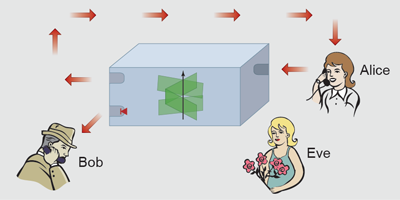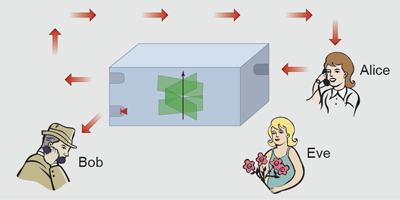Alice and Bob Go Nonlinear
Nonlinear devices added to linear systems often yield new, useful phenomena, an example being frequency-doubling crystals that combine two laser photons to create a photon of twice the energy. In a paper in Physical Review Letters, Matthew Frazier and colleagues at the University of Maryland, College Park, report experiments in which they put a nonlinear frequency-multiplying device into a chaotic bath of electromagnetic waves and find signal propagation effects that might launch a new kind of secure communication.
The equations that describe electromagnetic waves are linear and time invariant, which means that signals propagating forward in time can be recorded, played backwards (i.e., time reversed), and sent back along the incoming path, returning exactly to their source. Frazier et al. built a metal box with ports to couple microwave radiation in and out. Two of the ports are equipped with conventional linear antennas, but the third is an antenna incorporating a nonlinear element (in this case a diode). A scattering device in the box creates a chaotic electromagnetic environment to mask the signals and ensure complex signal paths.
A signal sent into one linear port of the chamber will bounce around and eventually hit the nonlinear antenna, which responds by producing signals at new frequencies. These new frequencies are then recorded at the other linear port, and then played backwards into the box, whereupon they reverse their propagation and return precisely focused onto the nonlinear element, regardless of how complex the path is. Among the applications envisaged by the authors is a communications network in which messages broadcast by Alice in a wide area are picked up by Bob with a nonlinear receiver at a secret location (not even known to Alice). Only that location will receive the reversed playback; Eve the eavesdropper will only detect garbled signals from the chaotic wave environment. – David Voss





